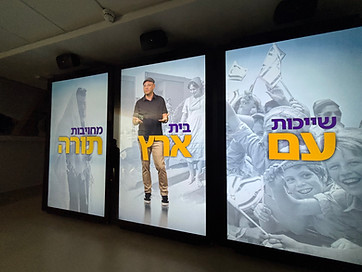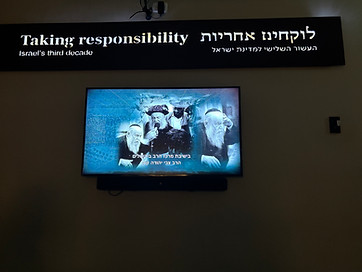Beit Hatziyonut HaDatit (Merkaz HaNeno) at Kfar Haroeh
Beit Hatziyonut HaDatit or Merkaz HaNeno is not a typical museum. Rather, it offers a 2 to 3-hour tour consisting of a high-tech, immersive journey tracing the historical development, core values and identity of Religious Zionism, and its challenges. The computer interactions are only in Hebrew, and a visit is only appropriate if you have a good understanding of Hebrew — although this could change in the future.
The must-have guide for exploring in and around Jerusalem
"In and Around Jerusalem for Everyone - The Best Walks, Hikes and Outdoor Pools"
For FREE, speedy, home, courier service from Pomeranz Booksellers in Jerusalem click here (tel: 02-623 5559) and for Amazon click here. To view outstanding reviews click here.
It’s easy to think of Religious Zionism as the equivalent of Modern Orthodoxy in America. But this would be inaccurate. American Modern Orthodoxy is Zionistic, but does not concern itself with the religious issues of living in a Jewish state, whereas this is a definite focus of Religious Zionism. To complicate matters, Religious Zionism is not the only form of orthodox Judaism in the State of Israel. Ultra-orthodox Jews or Haredim constitute between 13-15% of the population, while Religious Zionists (Dati Leumi) are between 8 to 10%. Haredim do not engage much with the state, although they do wield control over religious institutions such as the Chief Rabbinate, and Jewish marriage and conversions, and have considerable political power through coalition leverage. Religious Zionists do engage with the state, and punch above their weight in the Israel Defense Forces officer corps, the national religious education system, the settlement enterprise, and right-wing politics. This means that the challenges facing Religious Zionism are the challenges facing Judaism in general in Israel. Hence, the museum should be of interest not only to Dati Leumi Jews, but to everyone interested in the topic of religion in Israel and its political influence.
The building in which Beit Hatziyonut HaDatit is located was originally a yeshiva for training observant religious youth for farming. It was taken over for Yeshivat Kfar Haroeh by Rabbi Moshe-Zvi Neria, and it became a core institute of the “national‑religious” movement in integrating Torah study with secular learning. It thus became a precursor to the network of national-religious Torah high schools affiliated with Bnei Akiva (“Mamlachti dati” schools).
Kfar Haroeh (כפר הָרֹאֶ"ה) is a religious moshav (a cooperative agricultural village) situated in central Israel’s coastal plain, between Hadera and Netanya, established in 1933 by religious European immigrants. The name Kfar Haroeh does not mean village of a shepherd. Rather, "Haroeh," is an acronym honoring HaRav Avraham HaCohen Kook, the first Ashkenazi Chief Rabbi of Mandatory Palestine.
Directions and parking: Enter “בית הציונות הדתית” into Waze and click on “בית הציונות הדתית – חניה הישיבה כפר הרא״ה “. There is street parking.
Admission: Visits are for groups only. English can be accommodated, but the interactive computer feature is only in Hebrew. The center is open from 9 a.m. to 4.30 p.m. on Sunday to Thursday and 9 a.m. to 2 p.m. on Friday. The center is closed on Shabbat. A visit is suitable for families with children 8 years or above or above 10th grade. Admission is 55 NIS per person. Their phone number is 053 337-3142. This is their website
Public transport: Enter “בית הציונות הדתית” into Moovit and click on “בית הציונות הדתית HaYeshiva Street, Kfar Haroeh.” There is a 1.3-km/16 minute walk or 900-meter/11-minute walk from the nearest bus stops.

A tour lasts 2 to 3 hours. You will be led to a series of rooms that discuss the challenges faced by Religious Zionists during consecutive periods of years. You are equipped with a handheld computer and there also projections on the screen. You will be asked to identify with one of a few individuals in each room and how their challenges could be answered. The expulsion from Gaza, in particular, was a traumatic event for many Religious Zionists because of the settlement focus of their movement. There is a summing up at the end of the tour.




Links to the HOME PAGE and best family activities, hikes and historic sites in the GOLAN, EASTERN GALILEE, UPPER GALILEE, LOWER GALILEE, JORDAN VALLEY & LAKE KINNERET, the SHEFELAH, TEL AVIV-YAFFO and surroundings, NORTH of TEL AVIV, and SOUTH of TEL AVIV.